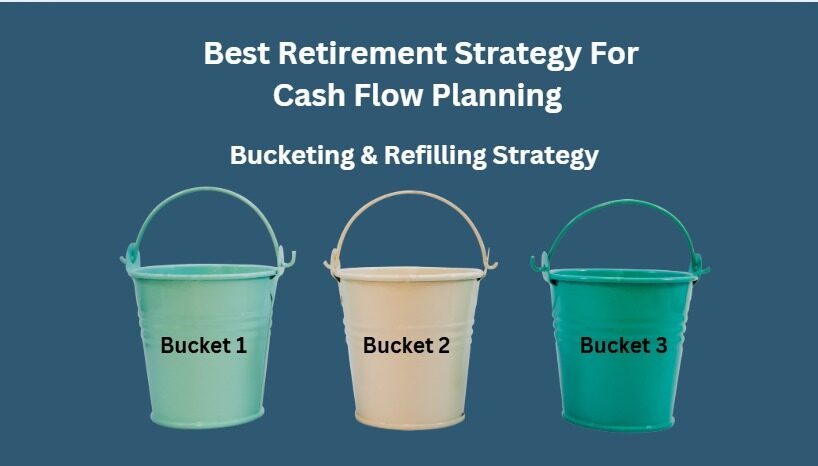Maximize Your Retirement Income :The Bucketing Strategy That Works
Retirement is a significant life milestone, and managing post-retirement cash flow effectively is crucial for ensuring financial security and peace of mind. One of the most efficient Retirement strategies for cash flow planning is the Bucketing and Refilling Strategy. This method allows retirees to structure their savings in a way that provides stability, Liquidity, Tax efficiency, regular monthly cash flow and growth, ensuring that their assets last throughout their golden years.

The world of retirement planning can be overwhelming. Even seasoned investors find it challenging to strike the right balance between stability, liquidity, and long-term growth
But whether you’re a financial expert or just beginning your retirement journey, I’m here to simplify one of the most effective strategies for post-retirement cash flow planning: The Bucketing and Refilling Strategy.
“From Stability to Growth: My Experience with the Bucketing Strategy in Navigating Market Uncertainty During Retirement. if you want to secure your retirement with a solid plan, mastering this strategy is the key.”
Table of Contents
The Bucketing Strategy divides your retirement savings into different “buckets” based on the asset class & category of funds. This segmentation allows you to allocate assets based on varying levels of risk tolerance and requirement for post-retirement cash flow planning .
Here’s a breakdown of the three primary buckets:
1. Bucket-1:
- Purpose: Capital Preservation & Regular Cash Flow for meeting monthly household expenses
- Asset Allocation: Primarily held in Fixed Income Instrument which is low-risk, no impact of market fluctuation.
- Investment Options: Fixed Deposit, Senior Citizen Savings Scheme (SCSS), Corporate Fixed Deposit, RBI Bond, PMVVY, Debt Mutual Funds, PPF, Tax Free Bonds, Government Securities, SDLs, PSU Bonds etc.
- Time Horizon: 1-3 Years+
- Tentative Return Expectation: 7.5%-8.5% (prevailing rate of interest)
- Cash Flow Frequency: Monthly/Quarterly/Half Yearly/Yearly Pay-out
- Taxation: Since its interest Income. Hence added to Individual Income (as per tax slab), except Tax Free Bonds & PPF Withdrawal
- Investment Strategy for Bucket 1: Retiree can allocate a certain % of Retirement corpus to Bucket-1, from where he/she can opt for monthly/Quarterly/Half Yearly Interest pay-out. Which can give a fixed monthly cash flow for meeting your basic household expense. Since all cashflow generated from Bucket 1 is taxable, therefore we will move to Bucket-2.
- Additional Income to be consider in Bucket-1: Retiree can also consider additional incomes like Pension, Annuity, Rental Income and Dividend Income. So when you add all cashflow from Bucket-1 & additional Income, you will get X amount of cashflow.
2.Bucket-2:
- Purpose: To generate tax efficient Cash flow through SWP on immediate or deferred basis to meet Inflation adjusted monthly household and discretionary expenses.
- Asset Allocation: Primarily held in Hybrid Funds which allocate money in various asset classed like Equity, Debt, gold, silver, Reits/Invits & Overseas and works on Dynamic rebalancing strategy as per valuation of each asset classes.
- Investment Options: Multi Asset Funds, Balanced Advantage Funds, Asset Allocator FOF, Aggressive hybrid funds etc.
- Time Horizon: 3-5 Years+
- Tentative Return Expectation: 10%-14% (based on past returns)
- Cash Flow Frequency: Monthly/Quarterly/Half Yearly/Yearly Pay-out
- Taxation: Income generated through SWP will be considered as capital gain income. Hence taxed as per current equity taxation.
- Investment Strategy for Bucket 2: Retiree can allocate a certain % of Retirement corpus to Bucket-2, from where he/she can opt for monthly/Quarterly cash flow through systematic withdrawal plan (SWP). Which can give a fixed monthly cash flow for meeting your basic household expense & discretionary expenses. Investor can opt for immediate SWP or deferred SWP as per their post retirement cash flow requirements.
- Important Note: Systematic withdrawal plan (SWP) rate should be lower than the expected rate of return from Bucket-2. This will ensures that not only you will get the tax efficient cash flow but also your principal amount will keep on compounding over a period of time. So when you add all cashflow from Bucket-2, you will get Y amount of cashflow.
3.Bucket-3:
- Purpose: To generate higher return (Alpha), which will enhance the overall portfolio return & periodically Bucket-3 profit will be used to refill either Bucket-1 or Bucket 2.
- Asset Allocation: Primarily invested in high risk & High return, long-term assets like equities,
- Investment Options: Equity Mutual Funds, Stocks (Direct equity), Portfolio management services (PMS), Alternative Investment Fund (AIF), Structure products etc.
- Time Horizon: 5 Years+
- Tentative Return Expectation: 12%-18% (based on past returns)
- Cash Flow Frequency: Bucket-3 should not be used for cash flow planning. It’s a growth engine in overall retirement portfolio.
- Taxation: Income generated through Buket-3 will be considered as capital gain income. Hence taxed as per current equity taxation.
- Investment Strategy for Bucket 3: Retiree can allocate a certain % of Retirement corpus to Bucket-3, where he/she take higher risk to generate higher returns in Post retirement portfolio, which will help the overall portfolio to beat the inflation.
- Important Note: Irrespective of short term market volatility, investor can continue to hold Bucket-3 portfolio without panic, since he/she is getting steady income on monthly/Quarterly basis to meet his/her post retirement monthly cash flow requirement.
The Refilling Strategy: Keeping Your Buckets Flowing
The Refilling Strategy ensures that your buckets never run dry by regularly replenishing them as funds are withdrawn. Here’s how it works:
- Refill Bucket 1: Every year or quarter, evaluate the performance of your long-term (Bucket 3) and mid-term (Bucket 2) assets. If your investments have grown sufficiently, transfer a portion of the profits into Bucket 1 to cover short-term needs for the next year or two.
- Refill Bucket 2: If Bucket 3 has performed well, allocate a portion of its gains to replenish Bucket 2 to maintain a balance of mid-term liquidity.
- Maintain Bucket 3: This bucket remains focused on long-term growth and continues to be invested in higher-risk assets to generate the returns needed to support future refills.
By refilling the buckets systematically, you maintain a steady stream of cash flow throughout retirement while keeping your assets aligned with your evolving risk tolerance.
Why the Bucketing and Refilling Strategy Works
1. Reduces Sequence of Returns Risk:
One of the biggest risks in retirement is withdrawing funds from investments when markets are down. The bucketing strategy helps mitigate this by ensuring that short-term withdrawals come from low-risk, stable investments. This reduces the likelihood of having to sell equities or other volatile investments at a loss.
2. Helps Manage Market Volatility:
By keeping short-term funds in low-risk assets, you have peace of mind knowing that market fluctuations won’t affect your immediate needs. The longer-term buckets can continue to grow, even if there’s temporary market volatility.
3. Tailored for Individual Needs:
The flexibility of the bucketing approach allows for customization based on individual retirement goals, risk tolerance, and financial circumstances. As life expectancy and healthcare costs continue to rise, having a system that adapts to your needs is vital.
4. Psychological Comfort
Having funds segmented into different buckets provides psychological comfort to retirees. You know that your short-term needs are secure, your medium-term goals are within reach, and your long-term aspirations are supported by growth-focused investments.
Implementing the Bucketing and Refilling Strategy
To effectively implement this strategy, consider the following steps:
- Assess Your Retirement Expenses: Identify your monthly and yearly expenses, including living costs, healthcare, and lifestyle desires. This will help you determine how much you need in Bucket 1.
- Evaluate Your Risk Tolerance: Understanding your risk appetite will guide how much to allocate in mid-term and long-term investments. If you’re risk-averse, you may prefer to keep a larger portion of your assets in Bucket 2.
- Regular Reviews: Periodically review your investments and overall financial plan. Adjust the allocations as needed based on market conditions, changes in personal circumstances, or evolving retirement goals.
- Work with a Financial Planner: The expertise of a financial planner can help tailor the strategy to your specific needs, ensuring that your cash flow remains steady throughout retirement.
Conclusion: Securing Your Retirement with Confidence
The Bucketing and Refilling Strategy provides a systematic approach to managing your post-retirement cash flow, combining liquidity with long-term growth potential. By segmenting your retirement savings into well-defined time horizons and periodically refilling your buckets, you can achieve financial stability and confidence in your retirement years.
At WealthBeats Finserv, we specialize in creating personalized retirement plans that incorporate this strategy, ensuring that your golden years are truly golden. Reach out to us today for a consultation and take control of your financial future.
Contact Us
For any queries, feel free to contact us—we’re here to help!

Vineet Baheti, CFP
With over 14 years of experience in wealth management, I am expertise in comprehensive financial planning, including tax planning, retirement planning, and goal-based planning for High-Net-Worth (HNI) and Ultra-High-Net-Worth (UHNI) clients. As a Certified Financial Planner (CFP, Certification Number: IN94288), I provide personalized strategies to help clients achieve financial security, optimize their tax positions, and plan for a prosperous retirement. My approach is centered around building tailored financial plans that align with individual’s unique goals, ensuring their long-term financial success.

